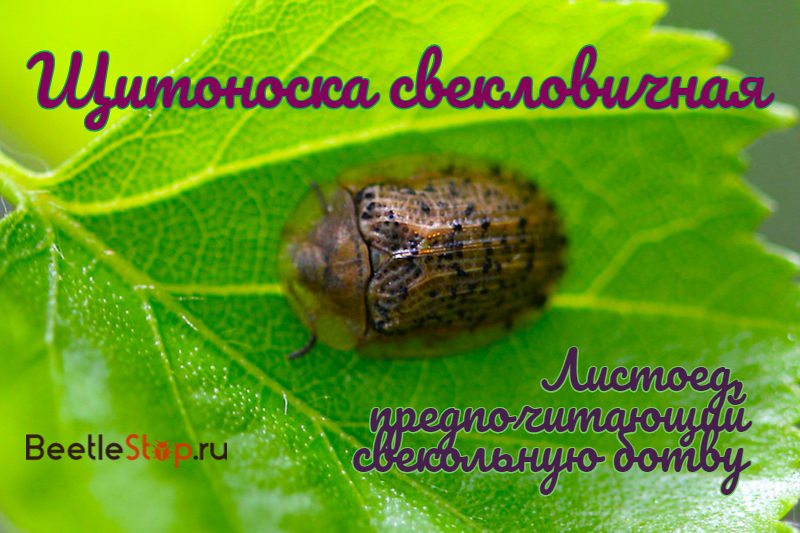Beetroot shield - how to protect the beet crop
Among the specialized pests of sugar beet, the most common type is beet shield. Beetles are found throughout Europe and North America in regions where beets are grown. Small insects seriously damage the tops, which negatively affects the development of the plant. In some cases, beetles act as agents for controlling weeds. Females lay eggs on weed grasses of the family Cactus (quinoa, yarut).

View description
Beetroot shield (Cassidanebulosa) is a representative of the leaf beetle family, the genus of the shield beetle. Another name for the insect is beet or ground bug. The genus Shieldbugs combined about 430 species, originally living in Africa, Asia, Europe. Several of them, including Cassidanebulosa, have been introduced to North America.
Interesting fact. The pronotum and elytra at the edges protrude beyond the contour of the body, forming a kind of shield over the head and abdomen. This feature gave the name to the genus Shieldbug.
The body of the imago is wide, oval, flattened. Length 5-7 mm. The upper part of the young beetle is greenish, with age the color becomes rusty-brown with black spots. Elytra covered with punctures from large points, longitudinal protrusions of carinae and grooves. Beetles have well-developed wings. The lower body is black. The limbs are rusty brown, short and thick, the segments of the legs are flat. The head is black, not visible from above due to the shield. Antenna serrated, 11-segmented. The top is thickened, but without the formation of a mace.
Larva
The flattened body of the larva narrows to the rear edge. They are larger than adults in size - 7-8 mm. The color is yellow-green, the head is reddish. On the back are two longitudinal light stripes. On the edges of the body spike-like growths, the rear pair is the longest. The end of the abdomen is raised.
Information. Larvae are characterized by wearing skins after molting and excrement at the posterior end of the abdomen.
Doll
A green flat doll keeps light streaks on the back. On the abdominal segments there are leathery processes with spikes.
Habitat
The distribution range of the shieldfish reaches 68 ° C. w. The ubiquitous species is found in Europe, Central Asia, Japan, China, North America. Insects settle in forests, fields, meadows. Sparse forest belts with weeds are selected. Beetles are narrow polyphages; they feed on plants of the haze family - quinoa, common gauze, and calendula.
Lifestyle & Reproduction
Adults appear in early spring, come out from under plant debris at a temperature of 7 °. For additional nutrition go to the quinoa and other weeds. With a large number of adults fly over to beetroot shoots. Beetles go to winter immature. After 6-8 days of intense nutrition, they begin to mate. Two generations are replaced in a year.
Breeding
The female lays eggs on the back of the plants on which she fed. In clutch of 6-20 eggs, covered with white mucus. In air, the secret hardens, forming a film. Egg laying can stretch for a month, the female fecundity is 200 pieces. After a week, larvae appear. They molt 4 times, development takes 15-25 days. Larvae live in groups. By the end of May or early June, they pupate on the leaves.The back of the body along with the discarded skin is attached to the sheet.
Information. In dry weather with a lack of food, larvae of older ages are prone to migration.
Pupa stage takes 5-8 days. Depending on the region, adults appear in June-July. After 10-14 days, they become sexually mature and begin to multiply. Beetles of the second generation emerge from the pupae in August. They do not mate, eat on beet crops. For winter hiding under plant debris, in the forests - under fallen leaves.
Malware
In addition to the dining room, fodder and sugar beets, the shield beetle harms spinach, artichokes, and sweet potato. Larvae of the first ages skeletonize leaves, later round holes gnaw out in the tops. The movement of plant nutrient juices is disrupted, which is detrimental to young seedlings.
Natural enemies
On eggs and pupae of beet shield insects parasitize wasp riders, bugs from the family of insects. The offspring of beetles are affected by pathogenic fungi.
Ways to fight
The main method of pest control is the destruction of haze weeds in the vicinity of beet crops. The lack of places for the development of larvae will negatively affect the number of beetles. With a massive defeat of crops (more than 10 larvae per 1 plant), insecticides are used. Double treatment with Bazudin, Sayrena preparations is carried out. In household plots, the pest is scared away by tincture of tobacco (50 g per 1 liter of water, insist 24 hours).

